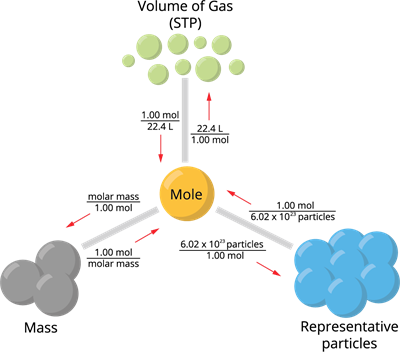
PUMPA - SMART LEARNING
எங்கள் ஆசிரியர்களுடன் 1-ஆன்-1 ஆலோசனை நேரத்தைப் பெறுங்கள். டாப்பர் ஆவதற்கு நாங்கள் பயிற்சி அளிப்போம்
Book Free DemoThe study of the collection of particles by using mole as the counting unit, in order to express the mass and volume of such unit particles in bulk of matter is known as mole concept.
The number of moles of a substance can be determined in several of ways depending on the data available, as follows:
- Number of moles of molecules
- Number of moles of atoms
- Number of moles of ions
- Number of moles of a gas (standard molar volume at STP =22.4 L)
Where, STP stands for "Standard Temperature and Pressure" (273.15 K, 1.00 atm)
Mole of atoms:
One mole of an element contains 6.023\times10^{23} atoms, and it is equal to its gram atomic mass, i.e., one mole of oxygen atom contains 6.023\times10^{23} atoms of oxygen, and its gram atomic mass is 16 g.
Mole of molecules:
One mole of matter contains 6.023\times10^{23} molecules, and it is equal to its gram molecular mass. i.e., one mole of oxygen molecule contains 6.023\times10^{23} molecules of oxygen, and its gram molecular mass is 32 g.
Molar volume:
One mole of any gas occupies 22.4 L or 22400 mL at STP. This volume is called molar volume.
Calculating the number of moles through different methods:

Mole concept